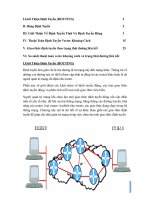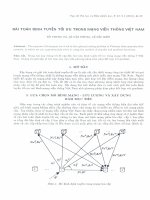Định tuyến Multicast groups
Bạn đang xem bản rút gọn của tài liệu. Xem và tải ngay bản đầy đủ của tài liệu tại đây (2.29 MB, 20 trang )
Multicast networking
Multicast
Broadcast
Class MulticastSocket
Using multicast
A peer-to-peer multicast chat system
A client/server multicast chat system
Wrapping up
Conclusion
Multicast networking
Multicast and broadcast
are datagram network
protocols.
Broadcast packets can not
get across a router, while
multicast packets can.
Multicast, thus, requires a
router to be multicast
aware: both the hosts and
routers must support
IGMP.
Multicast networking
Internet Group Management Protocol (IGMP)
Hosts willing to receive multicast messages
(packets) need to inform their immediately-
neighboring routers that they are interested in
receiving multicast messages sent to certain
multicast groups.
This way, each node can become a member of
one or more multicast groups and receive the
multicast packets sent to those groups.
The protocol through which hosts communicate
this information with their local routers is called
Internet Group Management Protocol (IGMP).
Multicast
A packet is sent to a multicast group.
All the interested recipients in the group
will receive the packet.
As with UDP, multicast is packet-based
and does not guarantee reliability.
Successful delivery may be different for
different recipients in packet lost,
duplication, and order.
Multicast groups
A multicast group is simply an IP
address that falls into IP class D
(224.0.0.0~239.255.255.255).
Recipients express an interest in
receiving packets addressed to a
particular multicast group.
The underlying network protocols
announcing this interest to relevant
routers on the network.
Multicast groups
To multicast is to simply insert a packet
into the network with the appropriate
target address.
A sender need not even be a member
of the group.
The packet will also be picked up by
routers that will forward it as appropriate
to adjacent networks that are interested.
The significant complexity of multicast is
how routers will know what adjacent
networks are interested.
Multicast groups
The MBone
The largest deployment of multicast on the
Internet is perhaps the Mbone.
A multicast packet is
transported as usual
within a island, but is
also picked up by
router hosts that
transmit the data
through TCP tunnels
to other router hosts
on other islands.
TTL-Time To Live
Multicast packets use a TTL field to limit
how far a packet will propagated.
The definition of the TTL field depends
on the routing protocol.
Reliability
There are other reliable multicast
protocols such as MTP, RAMP, RMP,
RMTP, RTP, TMTP, or XTP.
Broadcast
Similar at a local level to multicast:
every broadcast-based network has a
broadcast address.
Clients must
choose a UDP
port number
on which to
operate.
Multicast vs. broadcast
Multicast is preferable.
Multicast is often supported correctly, but
broadcast results in a permission error.
Multicast and broadcast result in almost the
same traffic.
From java, only a single client can listen to
broadcast to a particular port on a single
machine, while many clients can engage in
the same multicast conversation from a single
machine.
Class MulticastSocket
The MulticastSocket class extents the
DatagramSocket class by adding support for IP
multicast.
The additional methods are:
Methods to control group membership.
A send() method that allows the TTL of a multicast
packet to be specified.
Java does not support querying the destination
address of a received packet, so it is up to every
application to manually determine whether or
not any received packet is addressed to itself.
Security
Applets are restricted to receiving multicast
packets from a single host, from which they
came from.
They are usually
not allowed to
transmit multicast
packets.
IGMP must be
used
Using multicast
Using multicast is similar to using UDP
except that a TTL can be specified
when a packet is sent through a
MulticastSocket.
Using multicast
Receiving a multicast packet involves
one more step.
The receiver must join a multicast group
before waiting for packets to arrive.
An
code frag
ment
.
A peer-to-peer multicast
chat system
Multicast and broadcast allow the
development of true peer-to-peer applications
- there is no central server.
This example
shows how
clients in a
multicast-based
chat system
communicate
among each
other.
A client/server multicast
chat system
This implementation combines unicast
and multicast to overcome the Java
applet security limitation.
Each client unicasts its message to a
central server, which then multicast it
back to all the client.
This requires that the server must reside
at the Web server’s location to comply
with Java applet security limitation.
A client/server multicast
chat system
This system consists of two classes –
MixedcastChat and MixedcastServer.
A client/server multicast
chat system
To deployed as a web-based chat system, the
server must run on the same machine as the
web server.
Client can only connect if they are multicast-
connected to the server.









